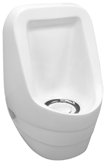
Waterless Urinals
Fact and Fiction
November 2008
This technical bulletin is designed to answer questions and
provide guidance regarding the viability of various types of waterless and low
flow urinals currently on the market.
In the summer of 2006, Naval Station Norfolk Public Works
Officer (PWO) Cdr. Chuck Smith Ret. requested a study of waterless urinals to
determine if these products should be mandated on future NavFac construction
projects. Waterless urinals qualify for LEED points and can help meet US Green
Building certification criteria. Three different manufacturers were invited to
install their products at no cost to the Navy for an extended evaluation. These
are the results of that two year study.
Background
Waterless Urinals are marketed as a complete replacement
for standard, one gallon flush urinals. Marketing materials predict how much
water will be saved if you use a particular manufacturer’s product. There are
however; a few caveats that accompany waterless urinals that make them
less-than-desirable for most applications and should be included for long range
planning and life cycle cost analysis (LCCA).
Issues experienced at Naval Station Norfolk associated with
waterless urinals are:
Recommendations
Three different manufacturer’s products were initially installed. Falcon/Sloan (Falcon manufactures for all Sloan waterless products) Zurn and Waterless. (This is an actual brand name)
|
|
Of the waterless products, it is our opinion that the Falcon/Sloan
unit is the one we would recommend when waterless products are
appropriate. |
All waterless units in the NAVSTA test building, Z-140, have been removed or are scheduled to be removed over the next year.
|
|
They are being replaced with Zurn Low Flow, 1/8 gallon flush models with a battery powered flush sensor. This is the unit we recommend for all new construction and retrofits. These low flow units provide 85% of the water savings associated with waterless units without the cartridge changing costs. The downside of the Zurn low flow product is that they are expensive. Current costs are over $500.00 per unit. It is expected that the unit cost will decline as economies of scale begin with manufacturing and also as other companies enter the low flow market and provide competition. |
Sloan has a similar 1/8 gallon flush product on the
market. Although their model was not available when this test was started, it is
expected to perform in a similar manner to the Zurn.
Both low flow models also qualify for USGB LEED points.
Very Respectfully,
Vince Marshall CEM, MBA
Regional Energy Manager
NavFac MidLant
v.marshall@earthlink.net